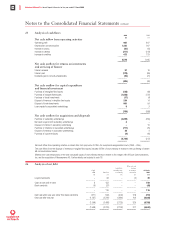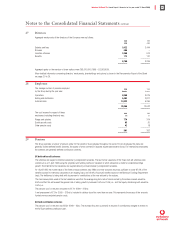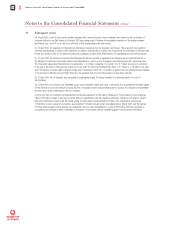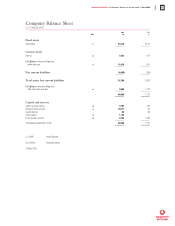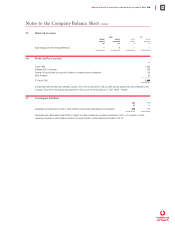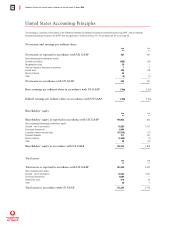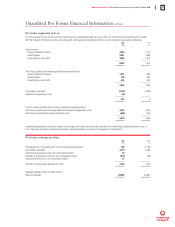Vodafone 2000 Annual Report Download - page 61
Download and view the complete annual report
Please find page 61 of the 2000 Vodafone annual report below. You can navigate through the pages in the report by either clicking on the pages listed below, or by using the keyword search tool below to find specific information within the annual report.
Vodafone AirTouch Plc Annual Report & Accounts for the year ended 31 March 2000 59
Summary of differences between accounting principles generally accepted in the UK and the US
The consolidated financial statements are prepared in accordance with accounting principles generally accepted in the UK (“UK GAAP”), which differ in
certain material respects from those generally accepted in the US (“US GAAP”). The differences that are material to the Group relate to the following
items and the necessary adjustments are shown on page 58.
Goodwill and other intangibles
Under UK GAAP, the policy followed prior to the introduction of FRS 10, “Goodwill and Intangible Assets” (which is effective for accounting periods ending
on or after December 23, 1998 and was adopted on a prospective basis) was to write off goodwill against shareholders’ equity in the year of acquisition.
FRS 10 requires goodwill to be capitalised and amortised over its estimated useful economic life.
Under US GAAP, intangibles arising on the acquisition of an equity stake would be capitalised and amortised over their useful lives.
Investments in associated undertakings, under US GAAP, can also include an element of goodwill in the amount of the excess investment over the
acquirer’s share in the fair value of the net assets at the date of the investment. Under UK GAAP, the treatment followed prior to the implementation of
FRS 10 was to write off the excess of the purchase consideration over the fair value of the stake in the associated undertaking acquired against
shareholders’ equity in the year of purchase.
Determination of the purchase price
Under UK GAAP and US GAAP the purchase price of a transaction accounted for as an acquisition is based on the fair value of the consideration. In the
case of share consideration, under UK GAAP the fair value of such consideration is based on the share price at completion of the acquisition or the date
when the transaction becomes unconditional. Under US GAAP the fair value of the share consideration is based on the average share price over a
reasonable period of time before and after the proposed acquisition is announced.
Deferred taxation
Under the UK GAAP partial provision method, deferred taxation is only provided for where timing differences are expected to reverse in the foreseeable
future. For US GAAP, under the liability method, deferred taxation is provided for temporary differences between the financial reporting basis and the tax
basis of assets and liabilities at enacted rates expected to be in effect when these amounts are realised or settled.
Tax benefit on option exercises
Under UK GAAP, the tax benefit received on the exercise of share options by employees, being the tax on the difference between the market value on the
date of exercise and the exercise price, is shown as a component of the tax charge for the period. Under US GAAP, the tax benefit is shown as a
component of paid-in capital on issue of shares.
Proposed dividends
Under UK GAAP, final dividends are included in the financial statements when recommended by the Board of directors to the shareholders in respect of
the results for a financial year. Under US GAAP, dividends are not included in the financial statements until declared by the Board of directors.
Earnings per ordinary share
Basic earnings per ordinary share has been calculated by dividing net income of £553m and £510m for the years ended 31 March 2000 and 1999,
respectively, by 27,100 million and 15,445 million, being the approximate weighted average number of ordinary shares outstanding for the years ended
31 March 2000 and 1999, respectively. For diluted earnings per share, the approximate weighted average number of ordinary shares outstanding for the
years ended 31 March 2000 and 1999 was 27,360 million and 15,510 million, respectively.
United States Accounting Principles continued



